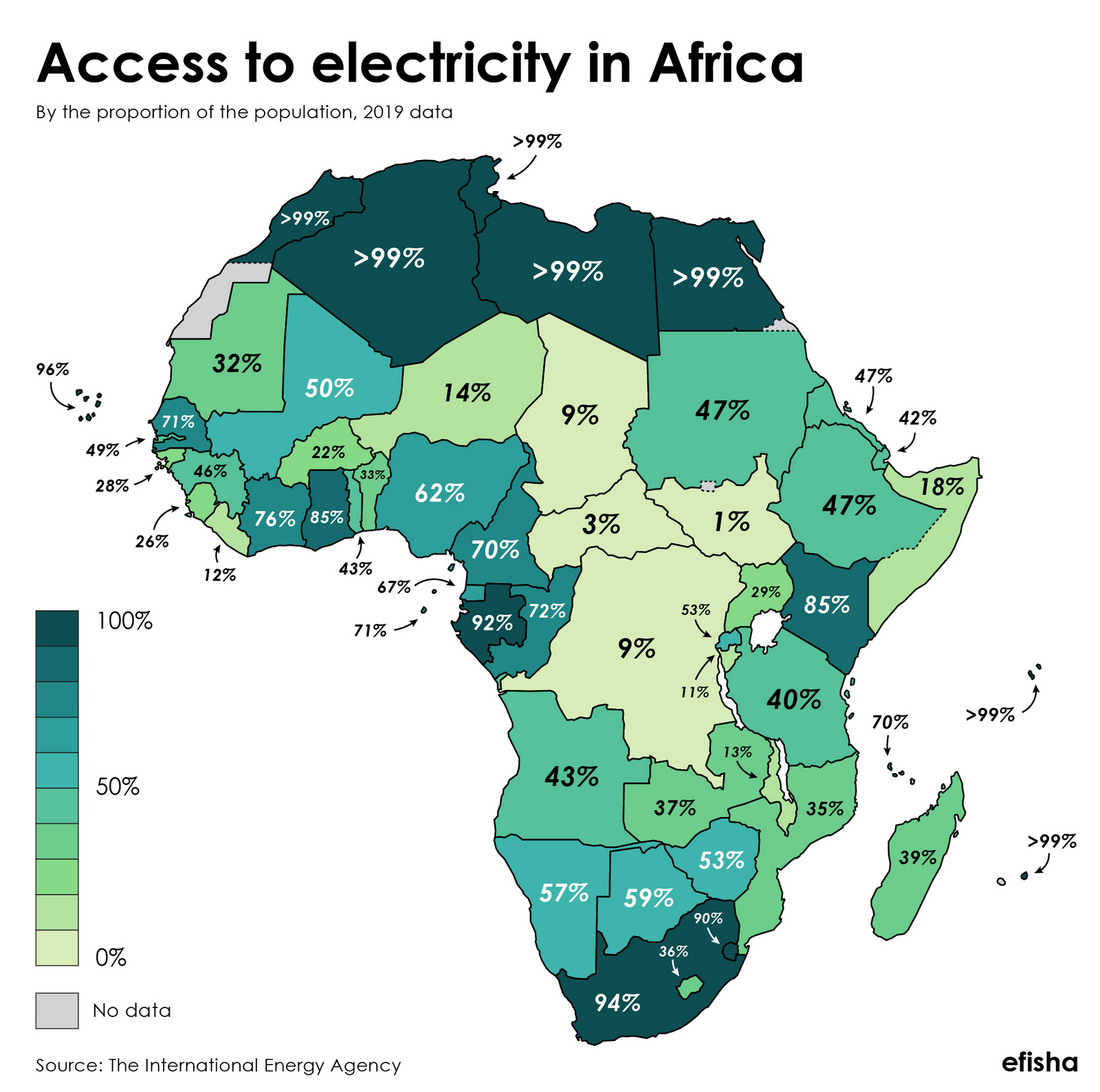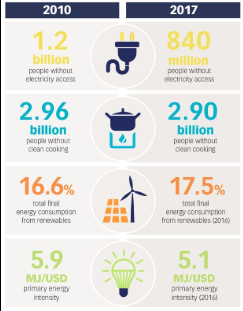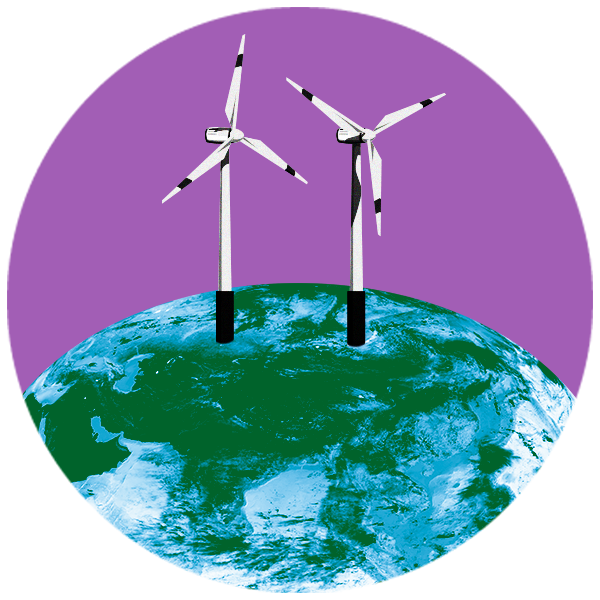Access To Electricity
Electricity is one of life’s basic necessities; however, not all areas of the world have equal access to this resource. Even today, many parts of the world have very little access to electricity which can significantly hinder economic growth and improved living standard.
Coupled with the Covid-19 pandemic and global energy crisis, it is becoming harder to provide total access to electricity worldwide. As of 2022, there are 774 million people without access to electricity (IEAI, 2022).
To overcome this issue, there are several initiatives governments can take to make energy easily accessible worldwide. If you want to learn more about this issue, here are some important statistics about access to electricity.

Access To Electricity In The Upcoming Years
With the rising population, it is important that actionable steps are taken to ensure large-scale access to electricity worldwide.
Apart from expanding energy infrastructure, there are several ways to make necessities more accessible. Here are some important statistics that look at the future of access to electricity in the upcoming years.
- In developing countries, current policies and initiatives are on track toward increasing overall access to electricity by 90% in 2030. This will be a significant increase from the current 82% worldwide electricity accessibility. Countries such as India and other Asian regions will be getting closer to bridging the energy inequality gap (Energypedia, 2022).
- Regarding the population without access to electricity, around 602 million people in sub-Saharan Africa are expected to have little to no electricity by 2030. This figure projects an upward trend of people having no access to electricity in this region, showing a 14 million increase from 2016 (Statista, 2022). With the growing population, it is important to reduce the gap when it comes to energy inequality. Human welfare organisation should focus their efforts on this region to meet the population’s basic energy requirements.
- Despite this increase in the energy inequality gap, there are some regions making positive steps toward improving access to electricty. In developing Asia, the number of population is expected to reach 54 million by 2030, showing an over 140 million decrease from 2016’s figure (Statista, 2022). This positive trend should be used as an example to increase access to electricity in other parts of the world.
- The world bank expects energy prices to decline by 11% worldwide. This prediction follows the 60% energy price hike experienced worldwide due to Russia’s invasion of Ukraine (Reuters, 2022) A decline in energy prices could potentially increase access to electricity for various parts of the population. Many demographics who previously had access to electricity had to give up this necessity due to rising energy prices; therefore, a price decline could have positive ramifications for this cause.

The Current State Of Access To Electricity
Access to electricity is an important issue as it directly affects the population's well-being. With uneven access to electricity, there is a larger economic divide in the world, leading to more inequality.
Over recent years, there has been an increased effort to improve this accessibility however, more work still needs to be done. Here are some important statistics that shine a light on the current stats of electricity accessibility.
- As mentioned before, there will be 774 million people without access to electricity in 2022. This number had increased from 2021/20, when there were 754 million people without access to electricity (IEA, 2022). 2020 has been a period of major change in terms of the global economic crisis. This crisis can be seen as one reason for the increase in people without access to electricity. Governments and human welfare authorities should take note of any shortcomings and improve them in the upcoming so that even during a global crisis, more people will have access to electricity.
- The global energy crisis has most significantly affected two regions - Asia and sub-Saharan Africa. In Bangladesh, approximately 10% of the 166 million population have no access to electricity (IEA, 2022). This statistic highlights key areas where human welfare organisations should try to improve access to electricity. These regions also have a fast-growing population; therefore, it is important to improve the electricity infrastructure to meet the growing demands.
- The covid-19 pandemic and global energy crisis due to the war in Ukraine have proven detrimental to equal electricity accessibility. At this current rate of progress, 670 million people will remain with access to electricity by 2030. This projection shows a 10 million increase than projected in 2021. (Irena, 2022). Since the onset of 2020, there have been multiple global crises that have affected access to electricity. Due to these reasons, there are more expected to be without electricity in the upcoming years. However, the UN and other organisations should apply fast-acting initiatives to improve progress in the upcoming years. Investing in renewable energy from natural resources is a great way to increase electricity capacity without increasing carbon emissions.
- Income inequality is one of the biggest reasons people cannot afford electricity. Almost 90 million people in Africa and Asia who previously had gained access to electricity can no longer afford to pay for their basic electricity needs (Irena, 2022). Rising fuel and food prices are disproportionately affecting developing countries and making it harder for these populations to have access to basic resources. To combat this issue, it is important to produce electricity that is affordable and accessible to a wider demographic.
- To reach universal access to electricity, experts recommend 100 million new connections every year reach this goal by 2030 (powerforall, 2022). If we look at the recent progress towards access to electricity, the momentum has been increasing significantly every year. Even though there was a slight drop due to the pandemic, it is possible to meet this goal by 2030. If the government and human welfare organisations take actionable steps toward increasing renewable energy accessibility, real change is possible. Investing in renewable energy will also ensure that the electricity supply is not disrupted due to any global crisis.
- The amount of funding requires for universal access to electricity varies according to region. To reach universal access to electricity in Sub-Saharan Africa by 2030, funding of 19.6 billion USD is needed. For developing Asia, proposed funding of 8 billion USD is required, and for the rest of the world, 2.6 billion would improve access to electricity (IEA, 2022). Government and human welfare authorities should take this report as a way to plan out steps towards improving universal access to electricity. This is a long-lasting investment as it will ensure economic growth and human development across the globe.
Despite current setbacks, there has been significant progress since the 2000s in improving access to electricity worldwide.
- In Africa, the number of people annually gaining access to electricity almost tripled from 8 million between 2000 and 2013 to 24 million between 2014 and 2019. The number of people with electricity access outpaced the population growth. As a result, the number of people with access to electricity peaked in 2013, with 613 million of the continent’s population. However, this number declined in the upcoming years, dropping to 572 million in 2019. (IEA, 2022). Much of this decline can be attributed to unequal access to electricity in the region. Organisations should make sure to provide electricity access to smaller countries as well as larger countries in Africa.
- On the other hand, initiatives in Asia have significantly improved access to electricity. Almost 1.2 billion people in this continent have gained access to electricity since 2000, with 97% of the region having access to electricity sources by 2020. Nearly two-thirds of this progress happened in India, where the government provided access to nearly 99% of the population by the end of 2019 (IEA, 2022). With this statistic, we can see that government0backed initiatives can prove successful when it comes to improving the accessibility of electricity. A core tenet of these initiatives was making electricity more affordable. Therefore, it is important to consider this an important aspect of improving access to electricity worldwide.

Access To Electricity According To Population
As mentioned before, not all population demographics have equal access to electricity. Some regions might have a much higher access rate than others.
Geographical factors and city planning often also play a role in the electricity access rate. Here are some important statistics that highlight how different regions have access to electricity.
- Between 2000 and 2020, the world’s urban population steadily gained access to electricity. Currently, 97.3% of the world’s urban population has access to electricity. In terms of region, Africa has a higher unequal accessibility rate however, progress is happening at a steady rate. (TheWorldBank, 2020). Urban population has always been quick to gain access to electricity due to more readily available infrastructure. Efforts should be made to maintain this momentum going forward.
- When it comes to the world’s rural population, the progress toward access to electricity has been uneven. Currently, 82% of the world’s rural population has access to electricity. This marks a 2% drop from 2019’s accessibility rate. (TheWorldBank, 2020). Due to geographical difficulties, most rural regions did not get proper access to electricity until the 2000s. Therefore there is a large disparity between urban and rural access to electricity infrastructure. With modern technology, it is important to make electricity accessible to various parts of the world with little hindrance.
How Fossil Fuel And Coal Affect Access To Electricity
Apart from fossil fuels, there are several others ways of generating energy. However, the type of energy also has an effect on its accessibility. Generally, oil generated from coal is one of the common forms of energy, but this is also detrimental to the environment.
Recently, there has been an increase in renewable energy sources, which are much more economical. Here is how different types of energy sources affect access to electricity.
- Coal is one of the largest sources of energy in the world. In 2021, coal generated approximately 759 TWh of energy. Most of this energy goes towards powering the industrial sector. However, due to high carbon emissions, there is a push towards reducing this power by 75% towards the end of 2030. (IEA, 2022). Even though coal is one of the most used energy sources in the world, it is extremely detrimental to the environment. Rising fuel prices also affect coal energy making it hard for everyone to access electricity. Therefore it is important to look for other renewable energy sources.
- Over 6 billion people in the world are dependent on fossil fuels and coal energy. This makes a large population of the world more vulnerable to geopolitical crises and tensions (un.org, 2022). Throughout the years, there have been several drops in terms of electricity access. This drop is often contributed to geopolitical crises that affect the distribution of fossil fuels. As a result, vulnerable populations lose access to basic energy requirements. To overcome this issue, it is important to invest in renewable energy, such as wind, solar, and water, to maintain consistent access to energy.

How Does Renewable Energy Affect Access To Electricity?
Energy is at the center of climate change, and it is important to invest in energy sources that will reduce carbon emissions and provide better access to electricity worldwide. Renewable energy often uses natural resources such as wind, solar, and water to generate electricity.
Governments and other human welfare authorities should look towards this type of energy to improve access to electricity worldwide. Here are some key facts about renewable energy and how it improves electricity accessibility.
- The current global projections for renewable energy sources indicate a 30% increase since 2006. This figure is expected to jump even higher by 2030 (McKinsey, 2022). With these statistics, we can track the awareness and demand for renewable energy sources. Since 2006 there have been low levels of interest generated this type of energy however, in 2015, there was a boom in terms of demand for renewable energy. Since then, the need for renewable energy sources has been steadily increasing. With this demand, people can expect better access to renewable energy sources in the future.
- It is possible to power almost the entire world through renewable energy sources. According to recent reports, 90% of the world’s electricity can come from renewable energy sources by 2050 (Irena, 2022). Even though this is a long-range forecast, it shows a lot of promise for the future. With this report, we can see that it is possible to improve access to electricity through renewable energy sources. In addition, switching to renewables will be far better for the environment. Organisations and governments should use this report to take actionable steps toward improving energy accessibility.
- Globally, experts forecast an 8% rise in renewable energy sources between 2022 to 2023 (IEA, 2022). Along with legislation and political support, people can start implementing renewable energy sources in their homes to make a meaningful impact. With more and more renewable being readily available, it is possible to increase accessibility to electricity worldwide. Instead of focusing on coal energy, more research and resources should be put forward on improving access to renewable energy.
- While there are multiple renewable energy sources, solar and wind take the lead in this category. Between 2006 and 2030, the demand for solar energy is expected to grow 30 times more. On the other hand, the demand for wind power is projected to be 4 times higher than the demand in 2006. (McKinsey, 2022). While the number on their own might not seem significant, they indicate a sharp increase in interest for wind and solar energy sources. When compared to demand rates in 2006, there has been a sharp increase in the need for such energy sources. This proves extremely beneficial for the fight against climate change and the need for clean energy sources.
- In 2020, renewable accounted for 29% of the electricity generated globally, with the majority coming from hydropower (16.8%). In total, a record-breaking amount of 256 GW of renewable power capacity was added globally in 2020 (c2es, 2022). As mentioned before, the demand for renewable energy sources is on an upward trend; therefore, we can expect more and more renewables to become readily available in the future.
- Many people are unable to access electricity due to rising energy prices. However, renewable energy is a far more economical option than fossil fuels. The energy cost from solar power fell by 85% between 2010 and 2020. The cost of offshore and onshore wind power fell by 48% and 56%, respectively (un.org, 2022). By tracking this trend, we can see that renewable energy is a viable option when it comes to increasing access to electricity. Many people are unable to afford basic electricity due to rising energy and food costs. With accessible and economical renewable energy, people will easily afford basic electricity.
- Affordability also affects how accessible renewables are. While the electricity from renewable infrastructures is cheaper, the cost to build and maintain these structures is very high. The cost of solar and hybrid grid connections has increased by approximately 20% in 2022. This is a significant increase from pre-pandemic price levels (IEA, 2022). The reason for these high prices is the lack of funding and support for renewable energy sources from some governments. With innovative technology being readily present, it is important to improve renewable energy infrastructure. As mentioned before, renewable energy is less likely to be affected by global crises; therefore, more effort should be taken to improve this resource.
- There are several countries adopting renewable energy as the most important source of electricity. In the UK, government legislatures aim for a net zero future by 2050. To reach this goal, the government is setting target providers so that all electricity comes from 100% zero-carbon generation by 2035 (nationalgrid, 2022). One of the best ways to make a real change toward reducing carbon emissions is by making large-scale changes to the energy infrastructure. With governments adopting renewable energy sources as one of the main power sources, people should expect better access to this power in the future. With more and more people moving towards renewable energy sources, we can expect a significant decrease in climate change. Other countries can use the success of renewables in the UK to introduce this energy in areas with low access to electricity.
Access to electricity is one of the most basic needs for every human being. As of now, there are several regions in the world without access to this basic necessity. Even though universal access has been on the rise in the past years, the pandemic and geopolitical crises have had an adverse effect on this growth.
Governments and human welfare organisations should use this downward trend as a lesson to introduce better funding and invest in more renewable energy to provide universal access to electricity by 2030.


